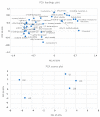Selection of Non- Saccharomyces Wine Yeasts for the Production of Leavened Doughs
- PMID: 36144451
- PMCID: PMC9501029
- DOI: 10.3390/microorganisms10091849
Selection of Non- Saccharomyces Wine Yeasts for the Production of Leavened Doughs
Abstract
Background: Non-conventional yeasts (NCY) (i.e., non-Saccharomyces) may be used as alternative starters to promote biodiversity and quality of fermented foods and beverages (e.g., wine, beer, bakery products).
Methods: A total of 32 wine-associated yeasts (Campania region, Italy) were genetically identified and screened for decarboxylase activity and leavening ability. The best selected strains were used to study the leavening kinetics in model doughs (MDs). A commercial strain of Saccharomyces cerevisiae was used as the control. The volatile organic profiles of the inoculated MDs were analyzed by solid phase microextraction/gas chromatography-mass spectrometry (SPME/GC-MS).
Results: Most of strains belonged to the NCY species Hanseniaspora uvarum, Metschnikowia pulcherrima, Pichia kudriavzevii, Torulaspora delbruekii, and Zygotorulaspora florentina, while a few strains were S. cerevisiae. Most strains of H. uvarum lacked decarboxylase activity and showed a high leaving activity after 24 h of incubation that was comparable to the S. cerevisiae strains. The selected H. uvarum strains generated a different flavor profile of the doughs compared to the S. cerevisiae strains. In particular, NCY reduced the fraction of aldehydes that were potentially involved in oxidative phenomena.
Conclusions: The use of NCY could be advantageous in the bakery industry, as they can provide greater diversity than S. cerevisiae-based products, and may be useful in reducing and avoiding yeast intolerance.
Keywords: Hanseniaspora spp.; bakery products; leavening ability; non-conventional yeasts; volatile organic compounds (VOC).
Conflict of interest statement
The authors declare no conflict of interest.
Figures




References
-
- Tamang J.P., Fleet G.H. Yeasts Diversity in Fermented Foods and Beverages. In: Satyanarayana T., Kunze G., editors. Yeast Biotechnology: Diversity and Applications. Springer; Dordrecht, The Netherlands: 2009. - DOI
-
- Belleggia L., Ferrocino I., Reale A., Boscaino F., Di Renzo T., Corvaglia M.R., Cocolin L., Milanović V., Cardinali F., Garofalo C., et al. Portuguese cacholeira blood sausage: A first taste of its microbiota and volatile organic compounds. Food Res. Int. 2020;136:109567. doi: 10.1016/j.foodres.2020.109567. - DOI - PubMed
-
- Garofalo C., Ferrocino I., Reale A., Sabbatini R., Milanović V., Alkić-Subašić M., Boscaino F., Aquilanti L., Pasquini M., Trombetta M.F., et al. Study of kefir drinks produced by backslopping method using kefir grains from Bosnia and Herzegovina: Microbial dynamics and volatilome profile. Food Res. Int. 2020;137:109369. doi: 10.1016/j.foodres.2020.109369. - DOI - PubMed
LinkOut - more resources
Full Text Sources
Other Literature Sources
Molecular Biology Databases
Research Materials
Miscellaneous

